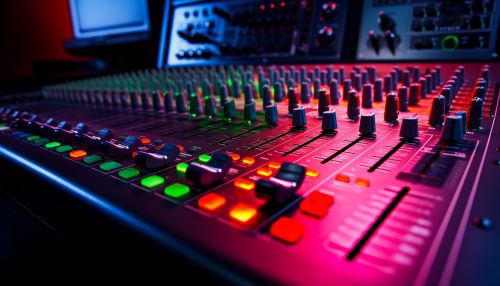A udio mixing
Overview
Audio mixing is a process used in sound recording and reproduction to balance and adjust various audio tracks to create a final "mix" of sounds. The process involves the manipulation of sonic qualities of an audio signal, including its volume, dynamics, and spatial position. The goal of audio mixing is to create a balanced blend of all the elements of a musical piece, ensuring that no one sound overpowers another, and that the overall effect is pleasing to the listener.


History
The history of audio mixing dates back to the early 20th century with the advent of electrical recording. The first electrical recording devices were essentially telephone transmitters, and the audio signal was mixed by adjusting the physical position of the performers around the microphone. As technology advanced, the process of audio mixing became more complex and sophisticated, involving multiple microphones, amplifiers, and later, mixing consoles.
Mixing Consoles
A mixing console, also known as a soundboard or mixer, is an electronic device for combining, routing, and changing the level, tone, and dynamics of audio signals. Mixing consoles are used in many applications, including recording studios, public address systems, sound reinforcement systems, broadcasting, television, and film post-production. A typical mixing console has multiple input channels. Each input channel has controls for adjusting the characteristics of the audio signal that passes through it.
Techniques
There are several techniques used in audio mixing, including equalization, dynamic range compression, panning, reverb, and delay. These techniques are used to enhance the sonic qualities of the audio tracks and create a balanced and cohesive mix.
Equalization
Equalization (EQ) is the process of adjusting the balance between different frequency components within an audio signal. EQ is used to enhance or reduce specific frequency ranges to improve the overall sound quality of the mix. The use of EQ in audio mixing can be subtle or dramatic, depending on the desired effect.
Dynamic Range Compression
Dynamic range compression, or simply compression, is a technique used in audio mixing to reduce the volume of loud sounds or amplify quiet sounds. Compression is used to control the dynamic range of an audio signal, which is the difference between the loudest and quietest parts of a track.
Panning
Panning is the distribution of a sound signal into a new stereo or multi-channel sound field. Panning is used in audio mixing to create the impression that a sound is moving from one side of the sound field to the other, or to create a sense of space and depth in a mix.
Reverb and Delay
Reverb and delay are effects that are often used in audio mixing to add a sense of space and depth to a mix. Reverb is the persistence of sound after it is produced, while delay is the echo of a sound that occurs after the original sound.
Digital Audio Workstations
In the digital age, audio mixing is often done using a digital audio workstation (DAW). A DAW is a computer-based system designed for the recording and editing of digital audio. DAWs have revolutionized the field of audio mixing, allowing for greater precision and control over the mixing process, as well as the ability to save and recall mixes.
Conclusion
Audio mixing is a critical component of the music production process. It involves a variety of techniques and tools, from mixing consoles and equalizers to digital audio workstations. The goal of audio mixing is to create a balanced and cohesive mix that enhances the overall sound quality of a musical piece.
